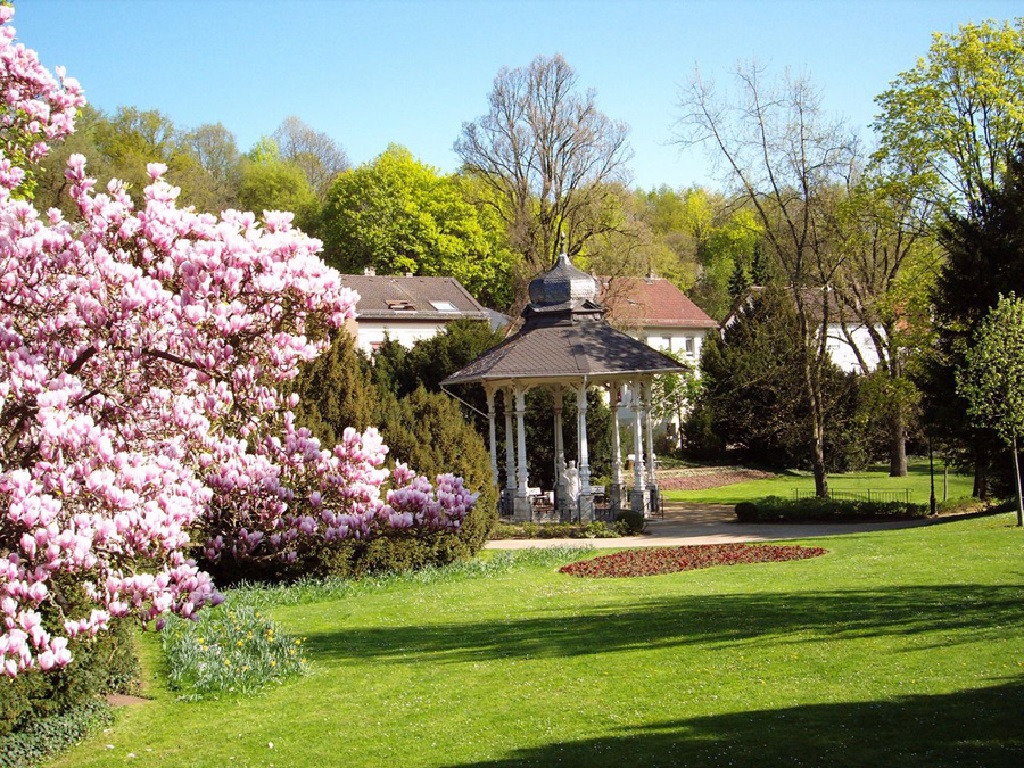Today
Františkovy Lázně is the smallest element of
the well-known and close-knit
west Bohemian spa triangle.
Spa Triangle
Františkovy Lázně is the smallest element of the well-known and close-knit west Bohemian spa triangle. It was founded in the late 18th century on the Baroque principle of axial symmetry and from the 1820s, it was gradually transformed into an ideal spa town with a regular chess-board street network spreading around the springs. It is one of the best preserved famous spa towns.
Reputation
Františkovy Lázně gained international reputation especially thanks to the successful treatment of gynaecological diseases and thus, they became a much sought-after destination among female clientele. It served as place of women's emancipation and democratisation of society.
Parks and Landscape
With its rectangular layout and uniform architectonic appearance, Františkovy Lázně represents a model spa town interwoven and surrounded with a characteristic triple belt of parks of the interior and exterior spa landscape with architecturally interesting pavilions housing the springs. The vast, mutually interconnected parks and gardens extend over a relatively flat terrain. The town may boast the world's oldest peat pulp baths and it inspired numerous music and literary works of world-famous composers and authors.
As in the past, balneology remains an essential part of the life in Františkovy Lázně, which currently belongs among the three most visited spas in the Czech Republic. Interestingly, the town with 5,500 inhabitants offers 4,500 beds in accommodation facilities. Spa guests and visitors may select from a variety of cultural events organised throughout the year.
Town Symbol
Do you want a baby but your attempts have been unsuccessful so far? You should come to Františkovy Lázně and touch the statue of František. As the symbol of fertility, the statue of František actually represents one of the "most powerful of the local healing resources" that, among other things, aids in the treatment of sterility in women and other gynaecological disorders. In fact, the healing properties are attributed more to the iron sulphate peat pulp.
The statue, called the "Brunnenbuberl" by the locals until 1945, began drawing attention in the 1950s when one of the local photographers taking photos of women standing in front of the statue of the boy made them smile by telling them: "Do you want a boy? Then hold his left leg!" The tradition continues with already the third statue of František made by sculptors Oskar Kozák and Jiří Lendr in 1967.
The original Mayerl's statue is displayed at the Municipal Museum. The small statue of the boy decorated the flower beds at the František Spring, which was called the "Buberlquelle" in the local dialect (the name literally means
"boy spring" and refers to its power to cure women's inability to conceive, hence the name "Brunnenbuberl").
Town Coat of Arms: Concordia parvae res crescunt
Unity creates power
According to the town chronicle, the coat of arms of Františkovy Lázně was conceived in 1853, i.e. one year after becoming independent. The shield is divided by a blue bend in the upper right field symbolising the Ohře River. The upper left field is green with six blue wavy lines representing the six then known curative springs.
The lower left field is divided crosswise. The upper yellow subdivision depicts a black eagle with its head looking on the right and holding the green serpent-entwined Rod of Asclepius in its claws. The symbol commemorates Doctor Adler (Adler means "eagle" in German) who played a vital role in the foundation of the spa.
The lower white field shows a walking red cock, which refers to another man merited for his contribution to the foundation of the spa. It was Supreme Burgrave Heinrich Franz Graf von Rottenhan who interceded on behalf of Františkovy Lázně with the Emperor. In German, "rot" means red and "Hahn" means cock.
The shield is encircled by a ribbon with the inscription "Františkovy Lázně", "Concordia parvae res crescunt" (Unity creates power)) and the date of the town's foundation "18 January 1852".
Partner Towns and Cities
Nizhny Tagil
Russia, Ural Federal District, Sverdlovsk Region
Download
- Mapa města.pdfPDF (5.1 MB)
